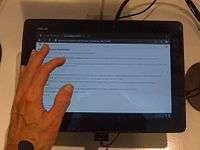Asus Transformer Pad TF300T
|
Asus Eee Pad Transformer TF300T | |
| Developer | Asus |
|---|---|
| Type | Convertible tablet |
| Operating system | Android 4.0 (upgradable to 4.2) |
| CPU | 1.3 GHz quad-core Nvidia Tegra 3 T30L |
| Memory | 1 GB |
| Storage |
Flash memory 16 or 32 GB, microSD slot (dock full size SD slot), unlimited Asus WebStorage |
| Display | 1280×800 px LED (aspect ratio 16:10) IPS (brightness 350 nits), 10.1 in (26 cm) diagonal, 149 PPI not Gorilla Glass |
| Graphics | ULP GeForce |
| Sound | stereo speakers(not separated), microphone, headset jack |
| Input |
|
| Camera | Front: 1.2 MP |
| Connectivity | |
| Power | 10 hours; 22 Wh Li-polymer battery, 15 hours with dock |
| Dimensions |
263 mm (10.4 in) H 180 mm (7.1 in) W 9.9 mm (0.39 in) D |
| Weight | 635 g (1.400 lb) |
| Related articles | Asus Transformer Pad Infinity |
| Website | Official website |
The Asus Transformer Pad TF300T is an Android tablet computer with a quad-core processor, and a successor to Asus Eee Pad Transformer Prime. The Transformer design includes an optional docking keyboard. The Asus Transformer Pad TF300T was released on the market in the U.S.[1] and Europe in May 2012.[2]
Features
The Asus Transformer Pad TF300T is a tablet computer with a LED 10.1" IPS 10-finger multi-touch screen with a resolution of 1280x800. This display is not Super IPS+ contrary to the ASUS Eee Pad Transformer Prime. The unit does not employ Gorilla Glass, and is therefore more susceptible to breakage.
The processor is an Nvidia Tegra 3 T30L at 1.2 GHz upon initial release with Android 4.0.X ICS, but overclocked to 1.3 GHz upon updating to Android 4.1 Jelly Bean (latest firmware is Android 4.2.1). The Transformer Pad TF300T has 1 GB of DDR3 SDRAM, and an 802.11b/g/n Wi-Fi module.
At the front of the tablet there is a 1.2-megapixel camera for video conferencing. On the back is an 8-megapixel (5-element lens) BSI CMOS sensor with autofocus camera which can be used for capturing HD videos with 1080p resolution.
The TF300 was the first 'non-Nexus' device to receive Android 4.2 'Jelly Bean'.
Docking keyboard
The optional docking keyboard features full QWERTY keys, trackpad as well as an additional battery that increases overall battery life from 8.5 hours to up to 15 hours.[3]
There are multiple reports of the screen cracking due to the amount of stress the hinges puts on the screen when opening and closing the unit.
Weight: 640g without the keyboard. The weight of the docking keyboard is 546g.
3G and LTE models
A 3G model supporting HSPA+, HSDPA and quad-band GSM has been released as the TF300TG.[4]
An LTE model supporting the above cellular standards as well as LTE has been released as the TF300TL.[5]
Custom ROM Development
CyanogenMod 11 or later, an unofficial updated version of Android (operating system) can be installed onto the TF300T tablet.[6] In addition, the TF300 continues to be supported by an active community of aftermarket operating system developers at XDA Developers several years after its initial release.[7]
See also
References
- ↑ Hamblen, Matt. "Asus, Fifth and Rising in Tablet Market". techhive.com. Retrieved 2015-10-06.
- ↑ "Asus Transformer Pad TF300T und TF300TG ab Mai erhältlich – LTE-Version folgt". t3n.de (in German). Retrieved 2015-10-06.
- ↑ "ASUS Transformer Pad TF300T". asus.com. Retrieved 2016-07-18.
- ↑ "ASUS Transformer Pad TF300TG". asus.com. Retrieved 2013-06-18.
- ↑ "ASUS Transformer Pad TF300TL". asus.com. Retrieved 2012-10-01.
- ↑ How to Install CyanogenMod on the Asus Transformer Pad ("tf300t"), wiki.cyanogenmod.org, retrieved on 2015-11-01.
- ↑ "Asus Transformer TF300T Forum on XDA Developers". XDA Developers. Retrieved 2016-06-29.
